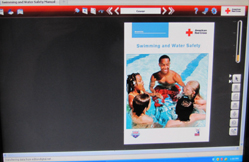Below is a transcript of the Red Cross video of how to swim butterfly, for my students to enhance their learning.

First, to be able to understand vocabulary about swim strokes, a transcript of the video section on stroke mechanics :
“Stroke mechanics are the basic elements of each stroke–body position, breathing and timing, arm stroke and kick. The focus of stroke mechanics is on making the most of propulsive movements while maintaining efficient body position and good body alignment. There are several terms you should understand before we begin studying individual strokes.
Body roll relates to the body position. It is the rotation of the body around the mid line–an imaginary line that runs down the center of a swimmer’s body. This rotation is important in the front and back crawl.
The power phase is the part of a stroke where the arm or leg moves the body in the right direction. The power phase of the arm stroke has three parts–the catch, the mid-pull and the finish.
The pitch refers to the angle of the hands as they move through the water. A good swimmer can feel a change in pitch because the water flow over the hand is different whenever the angle of the hand changes.
The recovery is the part of the stroke where the arms and legs relax and return to their starting position. Some strokes may also have a glide–a part of the stroke when the body keeps moving without any effort from the swimmer.
No two swimmers perform a stroke exactly the same way. You may need to adjust part of a stroke because of individual differences in body type, strength or flexibility. Understanding the basic elements of each stroke is the key to becoming a better, more efficient swimmer.”
Next: the transcript of the Red Cross video of how to swim butterfly.
“The butterfly is a powerful and graceful stroke. Learning correct timing and technique is the key to mastering this stroke.
The butterfly uses the whole body in a forward flowing motion. Moving together, your arms pull under water and recover over the surface of the water as your legs kick in unison upward and downward. Your body position is face down, horizontal and streamlined. Your body and arms drive forward together, powered by the fluid motion of your abdominals, hips and legs.
This continuous motion, combined with good timing, drives your body forward throughout the water. The kick, breath and pull work in harmony with one another to create efficient form.
There are two strong kicks for each arm stroke: the first occurs as your hands enter the water and the second occurs at the finish of the arm stroke.
As your hands enter the water, press forward and downward with your chin and chest while extending your legs for the down beat of the first kick. In the down beat of the first kick, your hips rise and your head and chest press forward. During the catch, your upper body begins to rise toward the surface and continues to rise during the mid-pull, while your hips drop and your knees bend to prepare for the second kick. Start the down beat of the second kick at the finish of the mid-pull. As the arm stroke finishes and the second kick ends, your hips lift again while your upper body stays near the surface to help your arms just clear the water during arm recovery.
Your upper body reaches its maximum height during the finish of the arm stroke and the end of the second kick. During the finish of the arm stroke, thrust your chin forward until your face clears the surface. Be sure to keep your mouth just above the surface to breathe; lifting your head too high will cause your hips to sink. Inhale as you start your arm recovery, then press down with your chin and chest to return your face to the water. Your head is on its way back down by the mid-point of the recovery.
Some swimmers breathe with every stroke; others take two or more strokes between breaths to increase speed and efficiency
In the arm stroke for the butterfly, both arms move together–catch, mid-pull and finish. The power phase begins with the catch as your hands enter the water. Your arms are extended in front of your shoulders with your finger tips pointing down and your palms facing your feet. As the catch progresses, your palms turn slightly outward as you bend your elbows and move your forearms and hands outside your shoulders. Keeping your elbows higher than your hands, press your forearms and palms to a point at the waist that is just inside the width of your body. As your hands push back, keep your elbows higher than your hands to finish the power phase. Continue to press your hands back past your hips. Your hands will finish slightly outside the width of your body. A forceful finish gives you a powerful burst of forward motion. Accelerate your arms all the way through the finish to make it easier for you to swing your arms out and around for the recovery. Both of your arms recover over the water simultaneously, and your arms stay almost straight.
The recovery starts as your hands exit the water. Leading with your hands, swing your arms out to the side just above the surface of the water. Keep your wrist relaxed and thumbs down throughout the recovery. Your hands re-enter the water in front of your shoulders. Continue to extend your arms forward and begin the next arm stroke. Now watch the entire arm stroke for the butterfly.
Use the dolphin kick when you swim the butterfly. Keep your legs and feet together and use a whip like motion. The kick starts at the upper abdominals and hips. Bend your knees to start the down beat. Extend your legs during the down beat, being sure to follow through; keep them straight on the up beat. Keep your ankles relaxed. Let your heels just break the surface. Think of the kick as a movement of your whole body, not just your legs. Now watch the entire butterfly stroke. Notice the timing, flexibility and rhythm.”
When people first start to learn to swim butterfly, they find that they do not have enough strength to lift both arms out of the water at once, but by trying to, develop more strength.
The Red Cross has notes (and some below are mine) about how most people progress as they learn butterfly :
Body position: trunk may be horizontal to 30 degrees from the surface; face in water
then: trunk horizontal to 15 degrees from the surface; head, trunk and legs are aligned with minimal movement to the left or right of the midline
and then:
body is nearly horizontal to the surface in a streamlined position
Kick: legs may be partially extended at the knee during the downbeat; minimal movement of the hip during the downbeat acceptable; legs may bend at the knees during upbeat— feet may break the surface; some flutter action acceptable
then:
legs may separate slightly at knees during kick with minimal flutter action; single kick action acceptable; hips flex and knees extended; knees slightly bent; hips raise as legs extend
then:
Legs can separate slightly at knees during kick—no flutter kick motion; two dolphin kicks;
legs extend during downbeat; legs straighten with ankles relaxed during upbeat; heels just break the surface
A common mistake is to have only one kick per arm pull. Instead, you should have a kick when your arms enter the water and a second kick when your arms sweep past your legs at the end of the pull. One of these kicks will be deeper than the other, and I have found that it happens naturally because of your body position, and my students do not need to think of which kick is deeper, but instead should concentrate on the timing of the two kicks.
Arms: Above-water arm recovery—arms may contact the water; hands may enter wider than the shoulders; arms may be straight at elbow during recovery and catch actions; palms face backwards throughout pull; power phase finishing at waist acceptable; arms may be bent at elbow during finish
then:
above-water arm recovery—straight elbow, occasional arm contact with the water acceptable; hands should enter at shoulder width, with fingertips facing down; arms partially bent at elbows; arms start wide then move to inside the width of body at waist; hands press back toward the feet past the hips
And finally, many people are able to keep both arms fully in the air.
Breathing and Timing: many people get to where they can have both arms fully out of the water, but they can’t also lift their head to breathe yet.
A common mistake is to lift your head and torso too high out of the water – when you do this you are using your muscles to mostly lift yourself up instead of lift up and forward and you are slower. Instead, your chin should just barely clear the surface of the water.
Arms pull and recover with minimal leg kick; arms may hesitate at side before recovery
then:
face-forward head lift begins at start of catch; head re-enters the water after taking breath and hands pull toward waist; one leg kick paired with each arm cycle at a minimum; arms should recover directly from the finish—minimal delay before recovery acceptable.
then:
Forward rhythmic breathing pattern on stroke each cycle; inhales during face lift and arm recovery
and exhales during underwater arm pull; forward and upward followed by forward and downward body
action paired with arm action and dolphin kicks; face exits water before the arms and re-enters the water before the arms
You can watch the video at the Red Cross swim teacher certification page. This video has more details than you can absorb in one viewing. My students who have seen it during classes multiple quarters in a row say they noticed something new each time.
To find the video go to
https://www.redcrosslearningcenter.org/s/candidate-water-safety
scroll down to the Videos section and click on Swimming and Diving Skills: Butterfly (it runs just over five minutes).
If you use Firefox as your browser, you might get an error message: “No video with supported format and MIME type found.”
Google Chrome and Microsoft Edge work as browsers.
If you would like to do some reading about swimming strokes, or swimming in general,
try the American Red Cross Swimming and Water Safety Manual.
Its public libraries number is 797.
This is the text for the Red Cross swimming teacher certification Water Safety Instructor.
A description of freestyle starts on page 116, backstroke on page 121, breaststroke on page 124, butterfly on page 128, elementary backstroke on page 133 and sidestroke on page 137.
It might be still downloadable for free. Go to
https://www.redcrosslearningcenter.org/s/candidate-water-safety
scroll down to Participant Materials and click on and open Swimming and Water Safety Manual.


(The American Red Cross Swimming and Water Safety Manual had no index, so I wrote one:
Swimming and Water Safety 2009 index).
The Cooper 12 minute swim test, which we do in my higher level swim classes, is on page 192, where it says “The 12-minute swimming test, devised by Kenneth Cooper, M.D., is an easy, inexpensive way for men and women of all ages to test their aerobic capacity (oxygen consumption) and to chart their fitness program.”
How can I tell if I’m a good swimmer? has more tests
Or should we call that page, how can I tell if I’m a fast swimmer?
See also: common errors in freestyle swimming
and Freestyle swim video transcript
Backstroke swim video transcript


